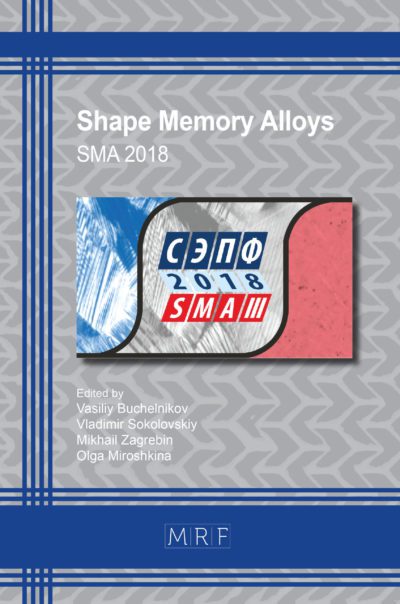Contactless temperature measurements on FSWed joints in aluminum and magnesium alloys
Iacopo Bianchi, Archimede Forcellese, Tommaso Mancia, Chiara Mignanelli, Massimiliano Pieralisi, Tommaso Verdini
Abstract. In this work, the heating distribution on similar and dissimilar friction stir welded joints in aluminium and magnesium alloys sheets was studied. Friction Stir Welding processes were performed using constant rotational and welding speeds of 1500 rpm and 60 mm/min, respectively. In order to obtain a completely non-intrusive and temperature monitoring measurement, a contactless method based on infrared thermography was used to analyze the temperature distribution over the welded area, near the tool during the Friction Stir Welding process. It was observed that the mechanical properties of joints are strictly related to the heat distribution. This system was used both to experimentally evaluate the temperature on the top surface of the joints and as it was able to detect the presence of flow defects with a contactless and non-destructive method, demonstrating the effectiveness of this measuring system as a diagnostic tool for the online quality control of welded joints.
Keywords
FSW, Similar and Dissimilar Joints, Light Alloys, IR Thermography, Non-Destructive Method
Published online 5/7/2025, 10 pages
Copyright © 2025 by the author(s)
Published under license by Materials Research Forum LLC., Millersville PA, USA
Citation: Iacopo Bianchi, Archimede Forcellese, Tommaso Mancia, Chiara Mignanelli, Massimiliano Pieralisi, Tommaso Verdini, Contactless temperature measurements on FSWed joints in aluminum and magnesium alloys, Materials Research Proceedings, Vol. 54, pp 1403-1412, 2025
DOI: https://doi.org/10.21741/9781644903599-152
The article was published as article 152 of the book Material Forming
![]() Content from this work may be used under the terms of the Creative Commons Attribution 3.0 license. Any further distribution of this work must maintain attribution to the author(s) and the title of the work, journal citation and DOI.
Content from this work may be used under the terms of the Creative Commons Attribution 3.0 license. Any further distribution of this work must maintain attribution to the author(s) and the title of the work, journal citation and DOI.
References
[1] M.A. Unnikrishnan, J. Edwin Raja Dhas, K. Anton Savio Lewise, J.C. Varghese, M. Ganesh, Challenges on friction stir welding of magnesium alloys in automotives, Mater Today Proc (2023). https://doi.org/10.1016/j.matpr.2023.03.789
[2] S. Rosenthal, F. Maaß, M. Kamaliev, M. Hahn, S. Gies, A.E. Tekkaya, Lightweight in Automotive Components by Forming Technology, Automotive Innovation 3 (2020) 195–209. https://doi.org/10.1007/S42154-020-00103-3/FIG.S/23
[3] M. Simoncini, A. Forcellese, Effect of the welding parameters and tool configuration on micro- and macro-mechanical properties of similar and dissimilar FSWed joints in AA5754 and AZ31 thin sheets, Mater Des 41 (2012) 50–60. https://doi.org/10.1016/J.MATDES.2012.04.057
[4] R.P. Singh, S. Dubey, A. Singh, S. Kumar, A review paper on friction stir welding process, Mater Today Proc 38 (2021) 6–11. https://doi.org/10.1016/J.MATPR.2020.05.208
[5] G.M. Revel, E. Sabbatini, M. Arnesano, Development and experimental evaluation of a thermography measurement system for real-time monitoring of comfort and heat rate exchange in the built environment, Meas Sci Technol 23 (2012) 035005. https://doi.org/10.1088/0957-0233/23/3/035005
[6] V.P. Vavilov, Thermal nondestructive testing of materials and products: a review, Russian Journal of Nondestructive Testing 53 (2017) 707–730. https://doi.org/10.1134/S1061830917100072/METRICS
[7] D. Lyu, H. Hu, X. Shen, X. Li, X. Wang, Research Progress on Ultrasonic Nondestructive Testing Technology for Metallic Additive Manufacturing Components: A Review, Russian Journal of Nondestructive Testing 2022 58:12 58 (2023) 1079–1106. https://doi.org/10.1134/S1061830922600757
[8] A.O. Chulkov, V.P. Vavilov, B.I. Shagdyrov, D.Y. Kladov, Automated detection and characterization of defects in composite-metal structures by using active infrared thermography, J Nondestr Eval 42 (2023) 1–16. https://doi.org/10.1007/S10921-023-00929-X/FIG.S/10
[9] A.O. Chulkov, D.A. Nesteruk, B.I. Shagdyrov, V.P. Vavilov, Method and Equipment for Infrared and Ultrasonic Thermographic Testing of Large-Sized Complex-Shaped Composite Products, Russian Journal of Nondestructive Testing 57 (2021) 619–626. https://doi.org/10.1134/S1061830921070044/TABLES/2
[10] S.C. Sun, H. Qi, X.Y. An, Y.T. Ren, Y.B. Qiao, L.M. Ruan, Non-destructive testing of ceramic materials using mid-infrared ultrashort-pulse laser, Appl Phys B 124 (2018) 1–18. https://doi.org/10.1007/S00340-018-6921-1/FIG.S/15
[11] B. V Firouzdor, AI-to-Mg Friction Stir Welding: Effect of Positions of Al and Mg with Respect to the Welding Tool The heat input and joint strength can be significantly affected by the positions ofAl and Mg relative to the tool, and lap joint welding can be modified to double the joint strength, SUPPLEMENT TO THE WELDING JOURNAL (2009).
[12] A. Forcellese, M. Simoncini, G. Casalino, Influence of process parameters on the vertical forces generated during friction stir welding of AA6082-T6 and on the mechanical properties of the joints, Metals (Basel) 7 (2017). https://doi.org/10.3390/MET7090350
[13] G. Ambrogio, C. Bruni, S. Bruschi, L. Filice, A. Ghiotti, M. Simoncini, Characterisation of AZ31B magnesium alloy formability in warm forming conditions, International Journal of Material Forming 1 (2008) 205–208. https://doi.org/10.1007/S12289-008-0027-Y
[14] Y. Yan, D. Zhang, C. Qiu, W. Zhang, Dissimilar friction stir welding between 5052 aluminum alloy and AZ31 magnesium alloy, Transactions of Nonferrous Metals Society of China 20 (2010) s619–s623. https://doi.org/10.1016/S1003-6326(10)60550-X
[15] R. Zettler, A.A.M. Da Silva, S. Rodrigues, A. Blanco, J.F. Dos Santos, Dissimilar Al to Mg Alloy Friction Stir Welds, Adv Eng Mater 8 (2006) 415–421. https://doi.org/10.1002/ADEM.200600030
[16] R.S. Mishra, Z.Y. Ma, Friction stir welding and processing, Materials Science and Engineering: R: Reports 50 (2005) 1–78. https://doi.org/10.1016/J.MSER.2005.07.001












